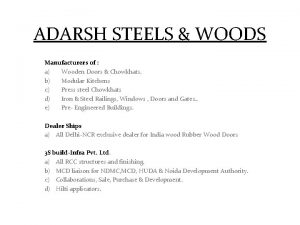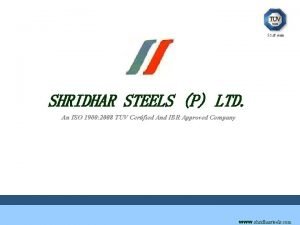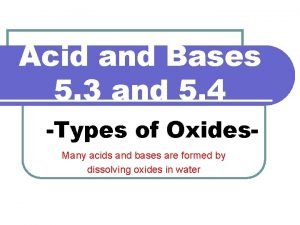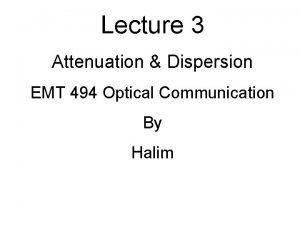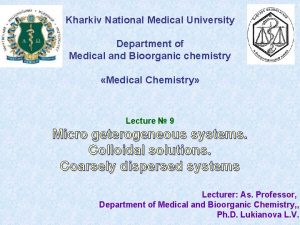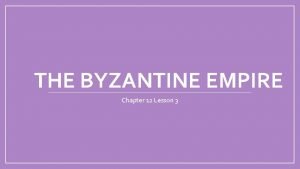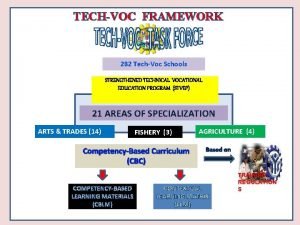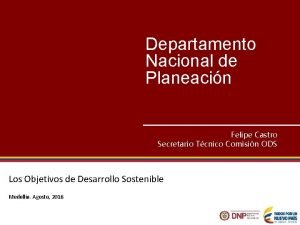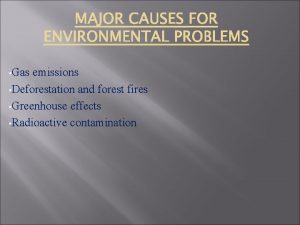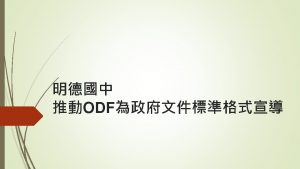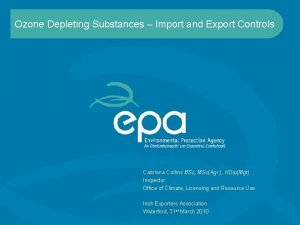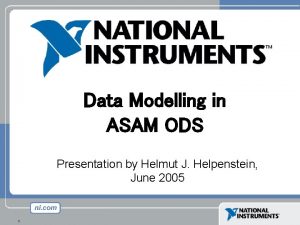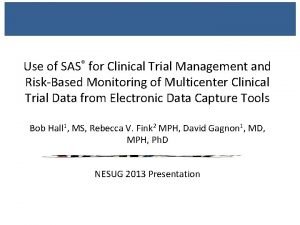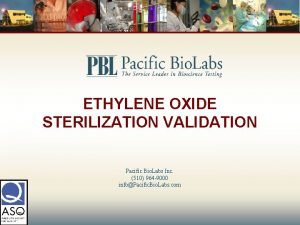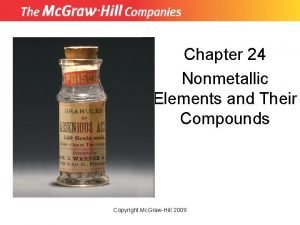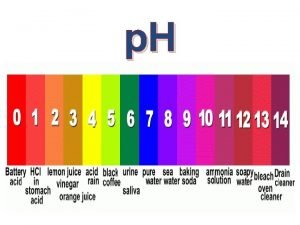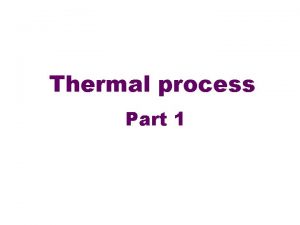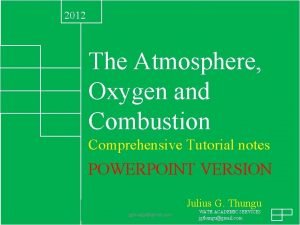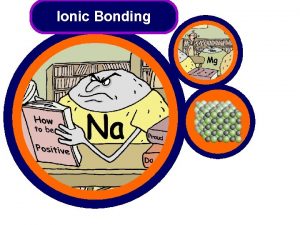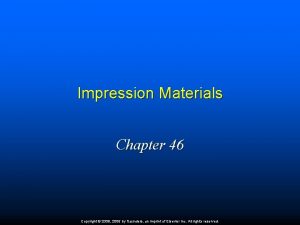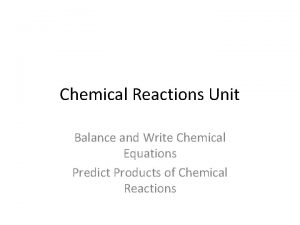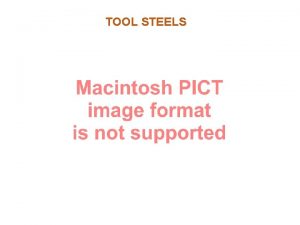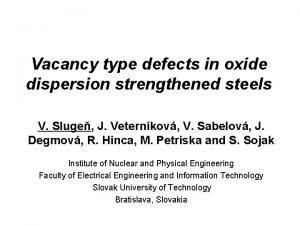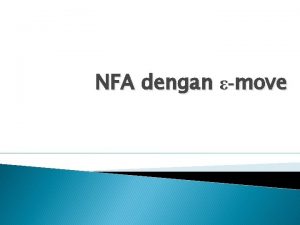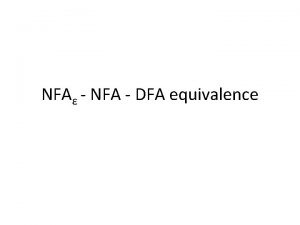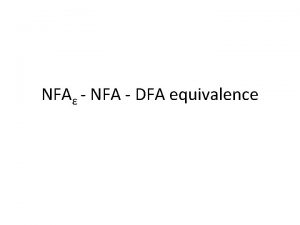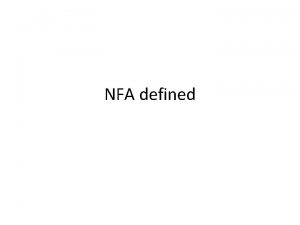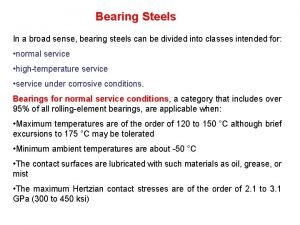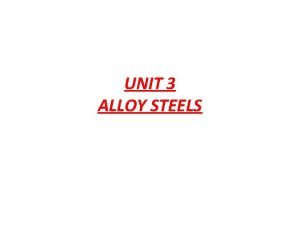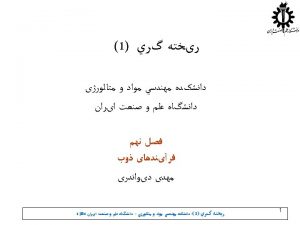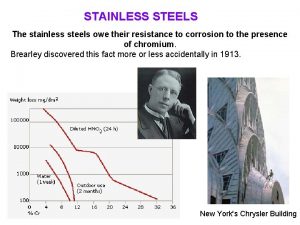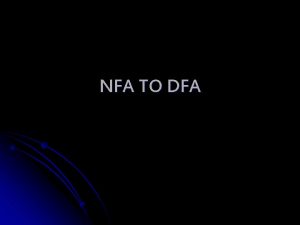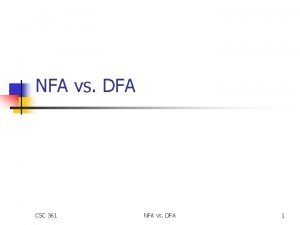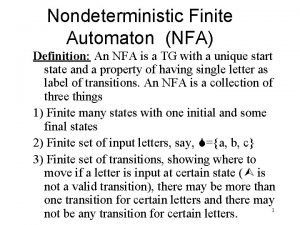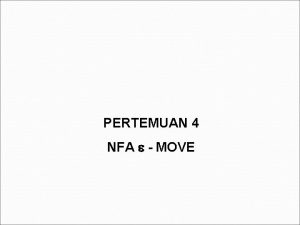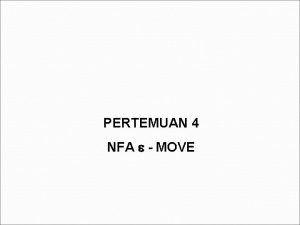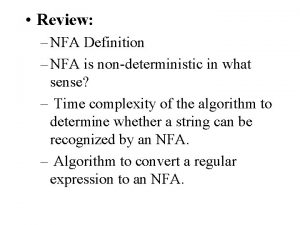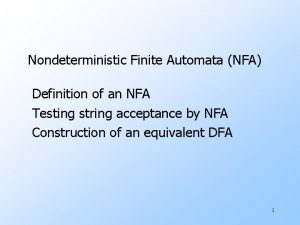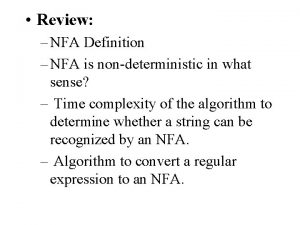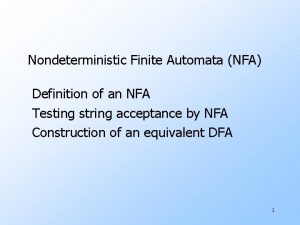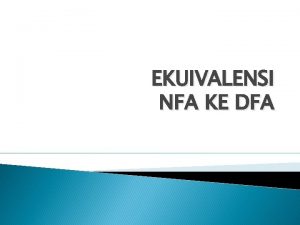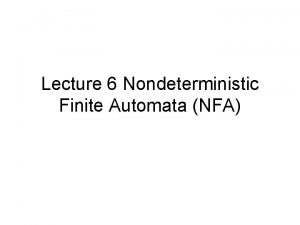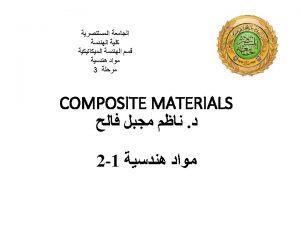ODSNFA Steels ODS Oxide Dispersion Strengthened NFA Nanostructured





























- Slides: 29

ODS/NFA Steels ODS - Oxide Dispersion Strengthened NFA - Nanostructured Ferritic Alloys D. T. Hoelzer Oak Ridge National Laboratory Fusion Materials Workshop University of Tennessee, Knoxville/Oak Ridge National Laboratory July 25 -29, 2016

Collaborations Primary Collaborators: Bob Odette UCSB Long term collaboration on NFA development Stuart Maloy LANL P. I. FCRD Project: Improved processing for scale-up of 14 YWT Other Collaborators: Thak Sang Byun PNNL Fracture toughness: High Temperatures INERI (KAERI): Development of ODS 9 YWTV Mikhail Sokolov ORNL Fracture toughness: Transition Temperatures Kinga Unocic ORNL Microscopy Meimei Li ANL Deformation mechanism maps Jeoung-Han Kim Hanbat National University, Republic of Korea

Overview • History, development and highlights of the advanced ODS Fe-Cr (14 YWT) ferritic alloy • FCRD Program on development of FCRD-NFA 1 • Fusion FOA Program on development of ODS Fe -Cr-Al alloys for Pb-Li compatibility

ODS steels and ferritic alloys • Oxide dispersion strengthened (ODS) ferritic alloys have long been viewed as having improved resistance to degradation of mechanical properties by neutron irradiation. • Two of the earliest ODS ferritic alloys developed for improved fuel cladding applications in liquid fast breeder reactors were: Ø DT and DY by CEN/SCK and DOUR Metal, Belgium Ø MA 957 by International Nickel Company (INCO), which was patented in 1978 • In 2001, Ti-, Y-, O-enriched oxide particles, or nanoclusters (NC), were observed in 12 YWT* • This discovery helped stimulate international R & D programs on development of 9 -12%Cr ODS tempered martensitic steels (TMS) and >12%Cr ODS ferritic alloys. * P. J. Maziasz, I. S. Kim, D. Larson, and M. K. Miller, ORNL SEED 1998

Mitigating Neutron Irradiation Damage Nano-size particles offer high sink strength to trap (getter) both vacancies (to enhance self-healing of damage by recombination with self-interstitial atoms, SIA) and He (in fine bubbles) NC n NC NFA n FMS He B v L i v n Dislocation Thanks to Bob Odette, UCSB GB

Development of the ODS 14 YWT • In 2001, R&D of 14 YWT began at ORNL with the Laboratory Directed R&D (LDRD) project (and collaborated with UCSB) - The composition (Fe-14 Cr-3 W-0. 4 Ti + 0. 25 -0. 30% Y 2 O 3) was selected - The mechanical alloying conditions leading to formation of nanoclusters were identified (SM 1 heat) • In 2002, R&D of 14 YWT continued with the INERI project - Collaboration between ORNL (Hoelzer), USCB (Odette) and CEA, Saclay (Alamo) from FY 02 -04 - Processing variables were investigated at UCSB and ORNL that provided further insight into forming NF/NC dispersions - Benchmark studies were conducted on MA 957 and 12 YWT at UCSB and ORNL to guide in development of 14 YWT - Nanostructured Ferritic Alloys (NFA) was coined for ODS ferritic alloys containing Y-, Ti-, O-enriched nanofeatures/nanoclusters • R&D of NFA continued with NEUP’s (UCSB) and an INERI (ORNL) that led to support by the Fuel Cycle Research and Development Program

10 year history of producing 13 heats of 14 YWT • Several heats used in ion and neutron irradiation experiments Production Date Mass (g) Temp. (ºC) SM 1 Apr 2002 200 850 Bi-modal grain size; EFTEM reveals Ti-, Y-, O-enriched nanoclusters SM 2 Feb 2004 200 850 Poor ball milling condition produced Bi-modal grain size SM 3 Mar 2004 200 850 SANS; Pb and super critical water corrosion tests SM 4 Mar 2004 200 850 First tensile tests; Steam corrosion test SM 5 Sep 2004 200 850 Navy ATR (Tensile and FT bend bars) SM 6 Jan 2005 800 850 First fracture toughness (FT) tests; HFIR and Matrix I (DCT, Tensile) SM 7 Aug 2005 1000 850 Navy ATR neutron irradiation (tensile and fracture) SM 8 Aug 2005 1000 850 Given to ORNL Basic Energy Science (BES) project SM 9 Aug 2005 200 850 10 h ball milling condition produced Bi-modal grain size SM 10 Jun 2007 1200 850 INERI (creep, FT bend bar, tensile); PNNL ion irr. (TEM); Matrix II SM 11 Feb 2010 1600 850 FCRD (fabrication, joining); MIBL ion irr. (bars) SM 12 (SM 200) Feb 2011 850 1175 Low C and N heat; PR and CR; HFIR JP 30/31 (FT, Tensile, APT) SM 12 (SM 185) Mar 2011 750 1000 Low C and N heat; PR and CR; HFIR JP 30/31 (FT, Tensile, APT) SM 12 (SM 170) Mar 2011 750 850 Low C and N heat; PR and CR; HFIR JP 30/31 (FT, Tensile, APT) SM 13 May 2012 5400 850 Heat produced for IAEA CRP; specimens for IRP (BOR-60) Heat History • SM = Special Metals atomized (Fe-14 Cr-3 W-0. 4 Ti) powder

Design strategy for developing the NFA 14 YWT Create a high interfacial area (sink strength) with nano-size grains and high density of Y-, Ti-, O-enriched nanoclusters BF TEM Grain size = 136 (+/- 14) nm (GAR = ~ 1. 2) EFTEM Fe M-jump ratio map Nv = 1 -7 x 1023 m-3 <r> = 1. 8 +/- 0. 4 nm

High sink strength of 14 YWT-SM 6 leads to high resistance to radiation hardening Fracture Toughness [MPa m • Tensile strength and fracture toughness were unaffected by neutron irradiation to ~1. 5 dpa at 300ºC (HFIR) KJc(1 T) (unirr. ) KJ 1 c (unirr. ) KJc(1 T) (Tirr. = 300ºC) KJ 1 c (Tirr. = 300ºC) Temperature (ºC) • No shift in FTTT observed after irradiation at 300ºC to ~ 1. 5 dpa S. J. Zinkle et al. , Nuclear Fusion, 53, (2013) D. A. Mc. Clintock et al. , JNM 392 (2009 353

Nanoclusters have a unique tolerance to irradiation 1 • NC appear to be stable to high dose, heavy ion irradiations at high temperatures Unirradiated - 14 YWT-SM 10 • Pelletron tandem accelerator at PNNL (now at Texas A&M) - 5. 0 Me. V Ni 2+ -3 dpa/s - 1 x 10 100 dpa at: ü 700ºC ü 600ºC ü 450ºC ü 300ºC ü 100ºC ü -75ºC 600ºC at 100 dpa

But, NC are unstable at low-temperature irradiations Start to disappear during irradiation at 300ºC, and completely dissolve at -75ºC Ø Ejected solute atoms from NC cannot back-diffuse to the cluster, or precipitate as a new cluster Nanoclusters exhibit “self-healing” behavior during irradiation at high temperatures Ø Nano-size particles precipitated after post-irradiation (-75ºC) annealing at 850°C for 5 hours Ø High number density ~1 x 1024 m-3 Ø Further analysis is still required to confirm their Y-, Ti, O-composition A. Certain et al. , JNM 434, (2013) 311 (JNM Best Paper Award 2013 -2014)

Tensile properties reveal different contributions to the strength and ductility of several 14 YWT heats . e = 10 -3 s-1 in air • Variations due to several factors: • For example, variations in grain size: Ø Grain boundaries, i. e. grain size Ø Precipitates, i. e. nanoclusters SM 4 417 48 nm Ø Dislocation forest hardening SM 6 387 80 nm Ø Matrix hardening SM 10 136 14 nm SM 12 732 47 nm • Usually: high strength, low ductility

Strengthening (YS) predictions from 25ºC to 800ºC NC strengthening Temp. (ºC) Orowan (MPa) Dispersed Barrier (MPa) n = 8 x 1022 n = 4 x 1023 m n = 8 x 1022 m n =4 x 1023 m -3 -3 -3 m-3 25 468 1196 178 417 200 432 1106 164 386 400 385 984 146 343 500 361 923 137 322 600 337 862 128 301 700 313 801 119 279 800 290 741 110 258 900 266 680 101 237 1000 242 619 92 216 • Forest dislocation strengthening is very high between 25 - 500ºC • Grain boundary strengthening is significant between 25 - 600ºC • Dispersed-barrier hardening agrees the best with the data Ø Strengthening by NC is not significant and is relatively athermal J-H Kim et al. , Mater. Sci. & Engin. A 559 (2013) 111

Nanoclusters control grain size by pinning grain boundaries from coarsening: Zener mechanism EFTEM Fe M Jump Ratio Image Local Electrode Atom Probe (LEAP) Grain boundaries M. K. Miller, D. T. Hoelzer and K. F. Russell, Materials Science Forum, V 654 -656, 2010

“Best practice” Processing of 14 YWT: Processing History of FCRD-NFA 1 • ATI Powder Metals: Y atomized with Fe alloy – Large ~55 kg heat (L 2314) produced: Fe-14 Cr-3 W-0. 3 Ti-0. 2 Y (low O) – Powder separated into 3 size ranges • Coarse: 150 -500 mm • Middle: 45 -150 mm • Fine: <45 mm • Powder Ball Milled at Zoz, Gmb. H – Parameters supplied by FCRD processing team – High kinetic energy CM 100 Simoloyer • Details of 3 ball milling experiments 1) Coarse size powders 2) Fine and middle size powders were mixed 3) A small quantity of ball milled coarse size particles were added to the fine and medium size powders

Recent processing efforts have focused on the contamination issues during ball milling • Undesirable pickup of O, C and N can occur during ball milling that affects the heat-to-heat variations of 14 YWT Interstitial levels of the atomized powder are from specifications for atomizing the powders • For the 14 YWT-SM 12 heat, the O level was increased with milling Y 2 O 3 powder, but the C and N levels were kept low • The 14 YWT-PM 2 heat was the pre-curser to the “Larger Best Practice Heat of FCRD-NFA 1 (formerly 14 YWT), that Bob Odette covered

14 YWT-SM 12 heats show significant improvement in high temperature-fracture toughness Sm 12 heats Ø FT of SM 12 heats are higher than 12 YWT and all 14 YWT heats Ø FT of SM 170 and SM 11 - High O, C and N levels SM 185 are similar to HT-9 Ø FT of SM 170 and SM 185 are above the goal of 100 MPa m 1/2 Ø Cleaner SM 12 heats of 14 YWT (lower C, N and O levels): • Enhanced grain boundary cohesive energy – hinder crack propagation • Fewer large M 23 C 6 carbides – crack initiation D. T. Hoelzer et al. , JNM 471 (20160 251 17

14 YWT-PM 2: Dual ion irradiations to 48 dpa and 2200 appm He at 650ºC in Du. ET (Kyoto, Japan) Fe 3+ ions accelerated to 6. 4 Me. V by a tandem accelerator and He+ ions are accelerated to 1 Me. V by a single end accelerator Underfocus Overfocus NC in 14 YWT-PM 2 <d> = 2. 1 nm N ≅ 1024 m-3 Y/Ti/O = 11/44/45 • Small bubbles, uniform size distribution are present in approximately the same number density as the nanoclusters Cavities T. Yamamoto et al. , Fusion Semiannual Progress Report, DOE/ER-0313/52, 2012

14 YWT-PM 2 shows high resistance to void swelling High-dose ion irradiation at the Kharkov Institute of Physics and Technology (KIPT) ESUVI accelerator - 1. 8 Me. V Cr 3+ ions 10 -2 dpa/sec (100 dpa/hr) Non-rastered beam 100, 300 and 500 dpa 400, 450 and 500ºC Tempered F-M steels reach terminal 0. 2% swelling rates 14 YWT and MA 957 exhibit an extended low swelling regime M. B. Toloczko, V. V. Bryk, F. A. Garner, D. T. Hoelzer and S. A. Maloy, FCRD Report , (2014)

“Best Practice” Processing of NFA 1: Plate production and SEM analysis • 12 plates of FCRD-NFA 1 (~120 cm x 80 cm x 1 cm) were produced by extrusion, cross-rolling and decanning • Grain size was 0. 779 +/- 0. 047 mm with 1. 02 GAR and small degree of bi-modal size distribution • Low number density of Ti(OCN) particle stringers observed

“Best Practice” Processing of NFA 1: LEAP Analysis High number density of nano-size O-enriched particles are consistent with previous 14 YWT heats Ti Ti. O O YO Y Y/Ti/O Y/Ti/Cr/O Number Density (1023/m 3) Diameter (nm) Solute Fraction (%) 13. 7/41. 8/44. 5 10. 5/32. 0/23. 6/34. 0 6. 86 2. 02± 0. 78 0. 74 Y-YO-O-Ti Map 20 nm NEUP, UCSB

NFA-1 Deformation & Fracture Properties/Mechanisms • Microstructure features of the extruded and cross rolled NFA-1 plate: • a high density of nano-size oxide particles and dislocations • a bimodal distribution of highly α-<110> fiber textured, predominantly fine (< 500) nm pancake shaped grains • a very large population of pre-existing ≈ 5 -30 µm microcracks laying in planes perpendicular to the broad plate faces • The mechanical properties were characterized in various orientations over a wide range of temperatures UCSB

NFA-1 Tensile Deformation and Properties • At 23°C, LT and TL orientations show high strength (σy > 1100 MPa) and moderate ductility (εt: 8 -11%), while LS and TS orientations show slightly lower strength (σy~ 1000 MPa) with higher ductility (εt: 8 -22%) • Strength decreases more rapidly at > 400°C as deformation transitions to viscoplastic creep; ductility varies, but remains significant • LT/TL or LS/TS delamination occurs at ≤ 200ºC by microcrack propagation • At ≤ 23°C, εt = 0 for loading in the ST/SL plate thickness directions due to unstable elastic propagation of brittle cleavage microcracks • A ST-orientation brittle-to-ductile cleavage transition occurs up to 100°C, but the effects of the pre-existing microcracks are felt up to 200°C LS (23 C) ST (23 C) σy εt LT (23 C) ST at different temperatures UCSB

NFA-1 Fracture Mechanisms and Toughness • Stable ductile crack tearing at -175°C and above in all orientations • Combination of low temperature strength and toughness due to crack deflection or splitting delamination transform tip stress states from plane strain (thick) towards plane stress (thin) ≈ 3 x lower stress concentrations • Crack tolerant NFA-1 has both high net section strength and ductility • Tensile tests ≤ 23°C low microcrack cleavage toughness (< 10 MPa√m) with a micro-master curve shape Stable crack growth RT to -175°C TL (-150ºC) UCSB

Development of ODS Fe-Cr-Al alloys • FOA project awarded in 2012 (Hoelzer/Pint) • The dual coolant Pb-Li and He (DCLL) blanket is the leading U. S. design for test blanket module for ITER and enhanced concepts of DEMO-type fusion reactor • RAFM (Fe-Cr) steels, as structural materials, are limited to ~475°C since Fe and Cr readily dissolve in Pb-Li at >500°C • ODS FM (<12 Cr) steels and ferritic alloys (>12 Cr) are attractive for increasing the maximum operating temperatures to >600°C and possessing excellent high-temperature creep properties and radiation resistance - The same issue with Pb-Li limits their feasibility also compatibility • Al 2 O 3 forming ODS Fe-Cr-Al alloys offer better compatibility with DCLL exposures B. A. Pint and K. A. Unocic, DOE/ER-0313/49, V 49, (2010), P 54

Development of ODS Fe-12 Cr-5 Al Alloys • Several ODS Fe-Cr-Al oxide dispersions were explored (wt. %) 1. 2. 3. 4. 5. 6. 125 YT 125 YZ 125 YH 125 LZ 125 YF 125 + 0. 30 Y 2 O 3 + 0. 43 Ti. O 2 125 + 0. 30 Y 2 O 3 + 0. 65 Zr. O 2 125 + 0. 30 Y 2 O 3 + 1. 12 Hf. O 2 125 + 0. 43 La 2 O 3 + 0. 65 Zr. O 2 125 + 0. 30 Y 2 O 3 + 0. 45 Fe. O 950°C Extrusion • Characterization of microstructure and oxide dispersions 125 YZ

Development of ODS Fe-12 Cr-5 Al Alloys • Good high temperature strength, but limited uniform elongation • Initial creep tests are excellent S. Dryepondt • Good compatibility in static Pb-Li K. A. Unocic and D. T. Hoelzer, JNM, 479, (2106), 357

Current and next steps in ODS alloy development Ø Joining: Friction stir welding shows promise, but proper parameters must still be determined Ø Fabrication: Understanding deformation during processing and fabrication still is incomplete Ø Irradiation: Ion irradiations are useful for studying the stability and He trapping mechanism of NC/NF, but neutron irradiations are needed for studying irradiation effects on mechanical properties

Friction stir welding of 14 YWT • Friction stir welding successfully joined 4. 25 mm thick plate samples of 14 YWT at ORNL Friction stir welded joint LEAP Analysis (5% Ti concentration isosurfaces) B. Mazumder et al. , JNM 469 (2016) • Other FSW attempts not so successful
 Adarsh nagar
Adarsh nagar Shridhar steels pvt ltd
Shridhar steels pvt ltd Acidic oxides formulas
Acidic oxides formulas Tyndall effect
Tyndall effect Intramodal dispersion
Intramodal dispersion Dispersion phase and dispersion medium
Dispersion phase and dispersion medium I am strengthened in him
I am strengthened in him Chapter 12 lesson 3 the byzantine empire
Chapter 12 lesson 3 the byzantine empire Strengthened technical vocational education program
Strengthened technical vocational education program Ods
Ods Varkula
Varkula Ods
Ods Excel 2007 ods
Excel 2007 ods Ods 5
Ods 5 Ods
Ods Sas visual analytics
Sas visual analytics What is the odds and ends kingdom
What is the odds and ends kingdom Proc odstext
Proc odstext Ods certificate customs format
Ods certificate customs format Asam ods training
Asam ods training Ods tagsets.excelxp
Ods tagsets.excelxp Ods to pdf
Ods to pdf Eto sterilizer thermocouple
Eto sterilizer thermocouple Oxide, peroxide superoxide formula
Oxide, peroxide superoxide formula Sodium carbonate and hydrochloric acid
Sodium carbonate and hydrochloric acid Blanket field oxide
Blanket field oxide Manganese oxide and hydrogen peroxide
Manganese oxide and hydrogen peroxide Charge of magnesium ion
Charge of magnesium ion Zinc oxide eugenol bite registration
Zinc oxide eugenol bite registration Balancing combustion reactions
Balancing combustion reactions
